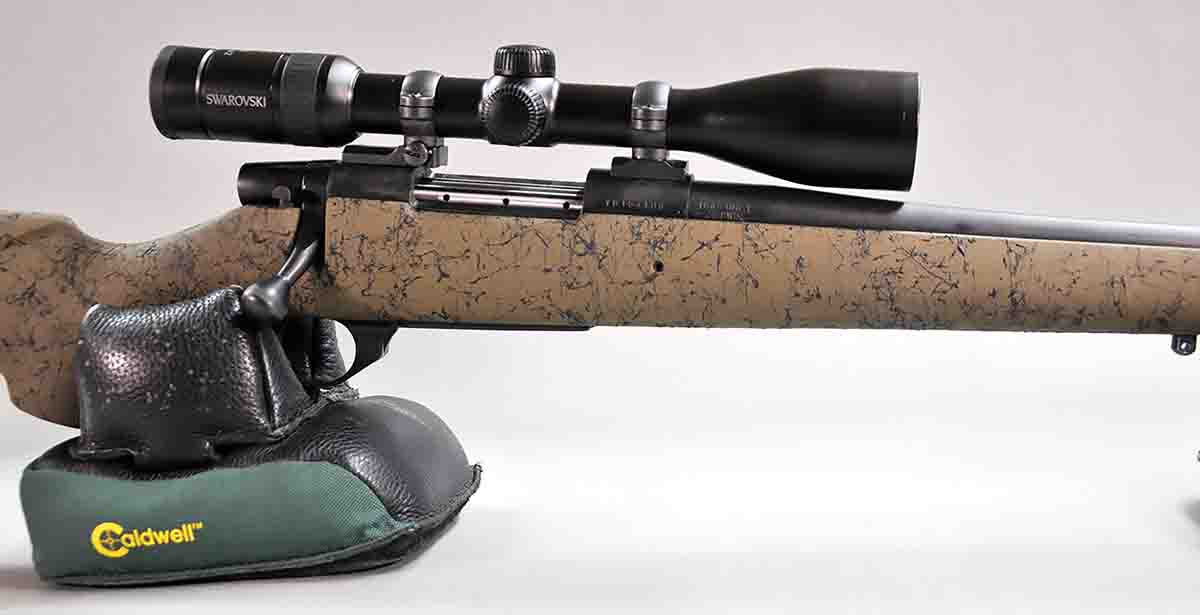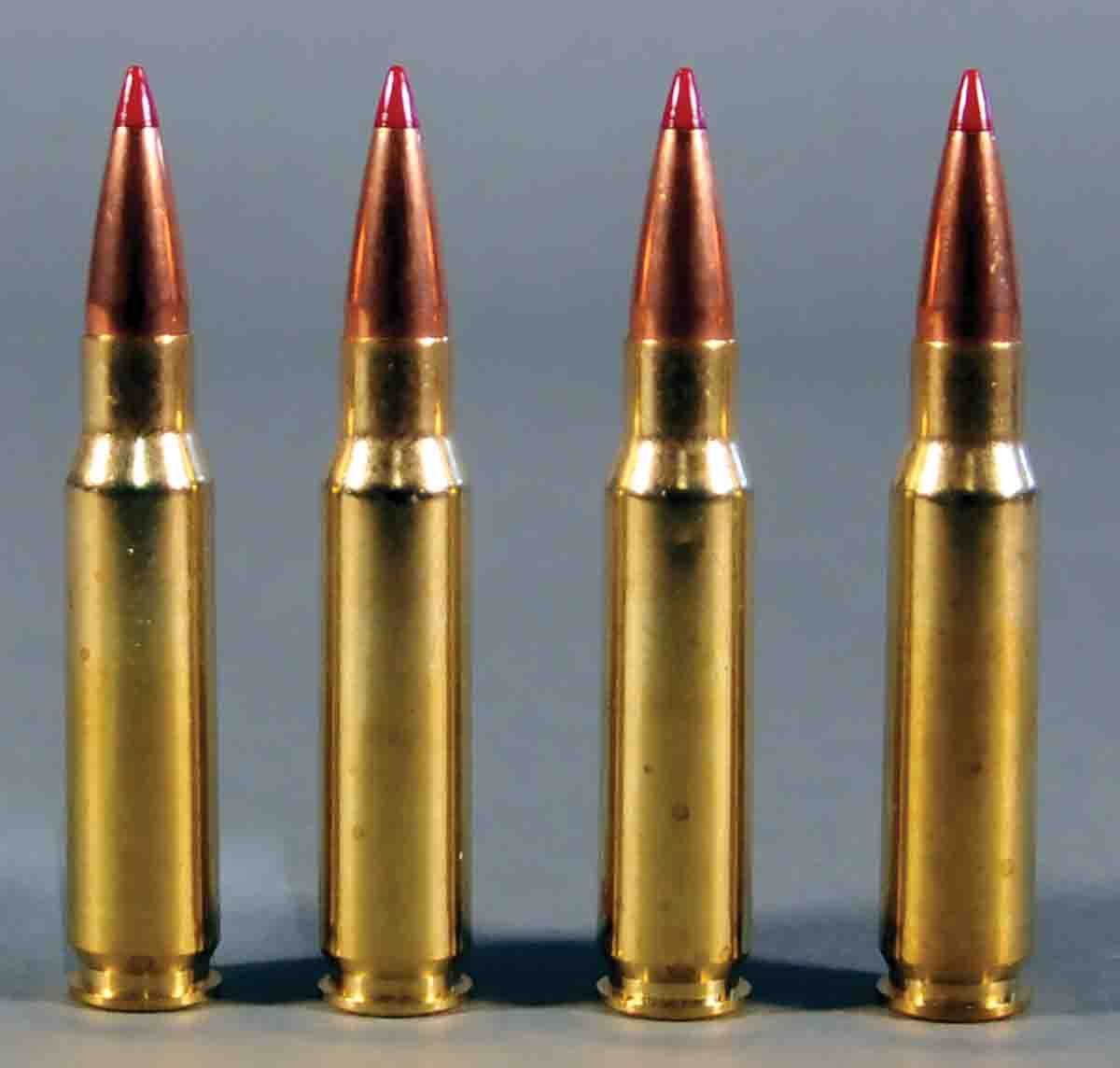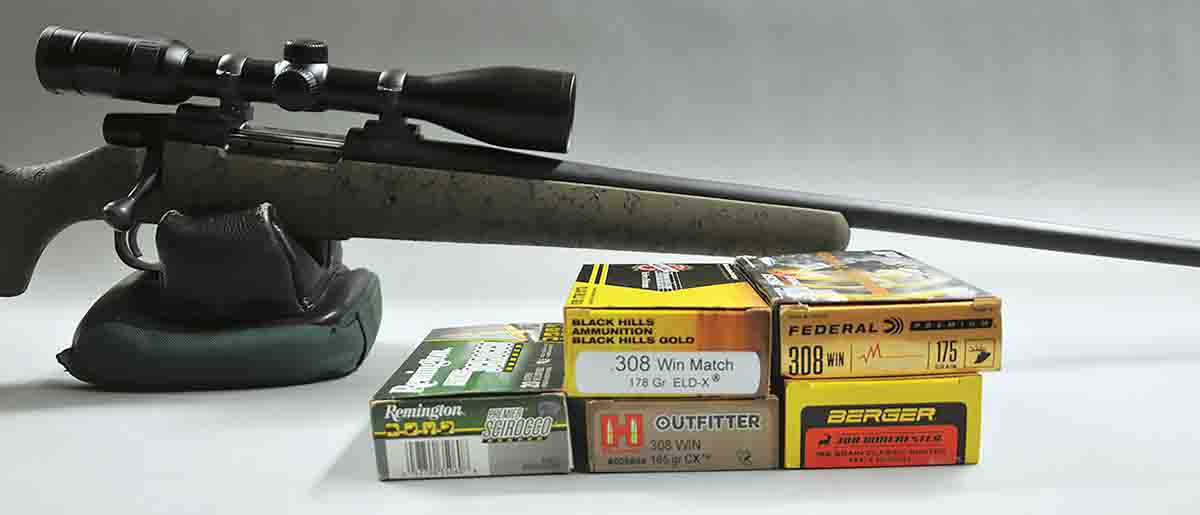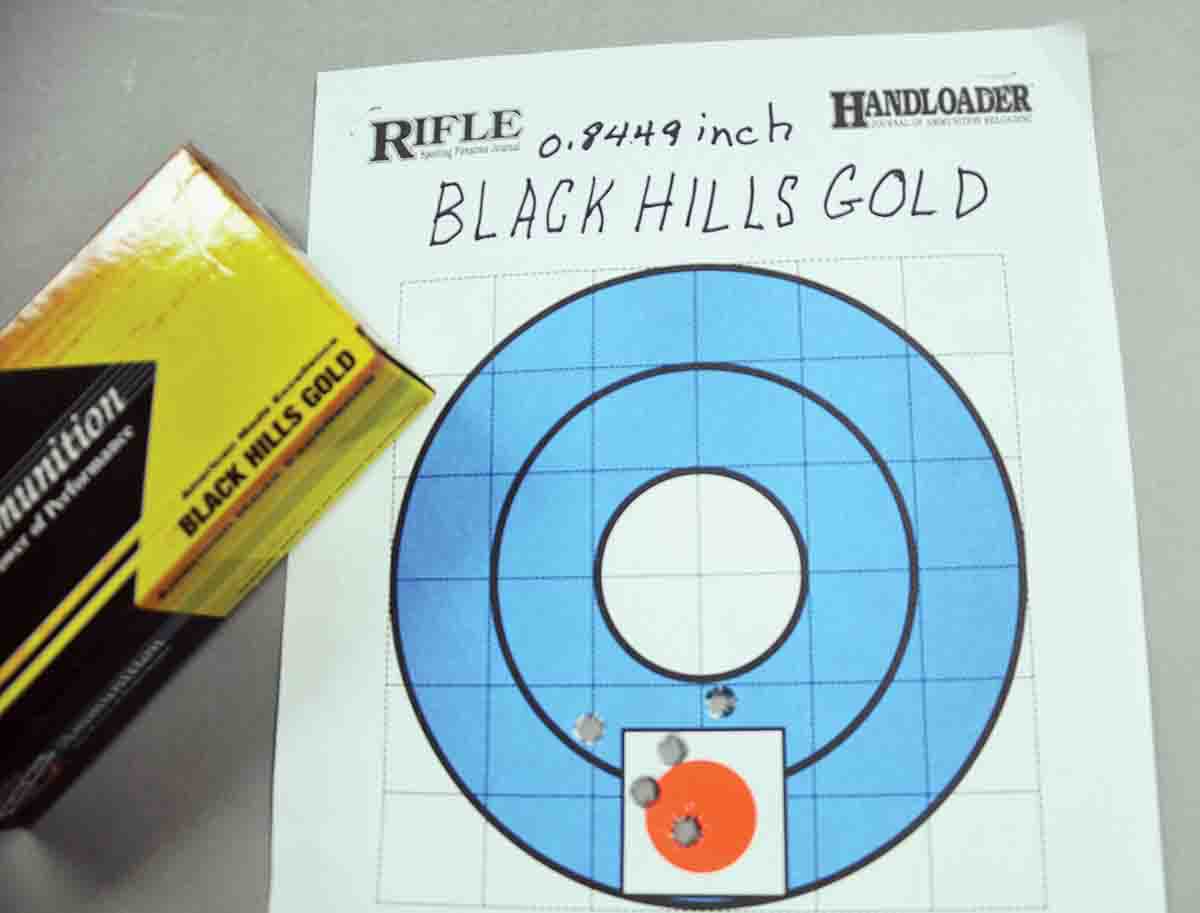
This new to the author Weatherby Vanguard 308 Winchester rifle was used to test all loads and it shot well with the loads tested.
Most serious hunters have a number of rifles in their personal collections, and it’s very likely, one or more of the rifles is chambered in the classic 308 Winchester. The highly versatile cartridge known around the world today as the 308 Winchester, is a clever byproduct of development conducted for the U.S. Army, who wanted to replace the aging 30-06. The U.S. military wanted to save space and the all-important brass used in manufacturing, wanted to provide weight reduction in order to enable the carrying more ammunition per man, and wanted better adaptability to automatic weapons.

This excellent Swarovski Z3 3-10x 42mm scope is a favorite and has been used in the field for several years. Like all Swarovski products, it provides superior clarity and aids accuracy.
Winchester, seeing the potential of such a cartridge for sporting purposes, jumped on the idea and, in 1952, introduced both the 308 cartridge and the Model 70 rifle chambered for it. This move by Winchester was two years before the 1954 NATO adoption of the T65E5 experimental cartridge iteration under the 7.62x51mm NATO designation and the rifle developed and chambered for it was the M14. Today, the military cartridge is referred to as the 7.62mm NATO.
When first marketed to riflemen, the 308 Winchester cartridge lagged in sales due to the continuing popularity of the 30-06 (still widely used today), but after 1960, as the NATO adoption became more commonly known, interest increased. U.S. veterans were returning from military service having grown accustomed to the M14, and later the M16, using the 7.62mm NATO cartridge. These veterans were all prime customers for the sister cartridge, the 308 Winchester and the custom-developed Winchester Model 70 rifle.

The Black Hills ammunition shot very well and represented the type of accuracy hunters need for big-game hunting.
Winchester advertised the M70 as a 6.5-pound rifle, and in 1955, the company produced the Model M88, a lever-action rifle chambered for the 308 cartridge. It wasn’t long before many manufacturers began developing sporting rifles to accommodate the somewhat shorter cartridge. These lighter rifles were appealing to hunters and increased the popularity of the 308 Winchester cartridge.
In 1978, the well-known, late Ken Waters, documented the many virtues of the 308 Winchester, of which he was a fan. He pointed out the never failing precision accuracy of the cartridge, stating the power of the compact cartridge very nearly approached that of the 30-06, while delivering significantly less recoil. He considered the cartridge remarkable for its adaptability to all types of rifle actions, including pumps, lever actions, autoloaders and even single shots, and he suggested it was the ideal choice for a one-gun owner for both hunting and target shooting use. The effectiveness of the 308 in hunting most all North American big game was another attribute he identified, as well as the power of the cartridge, which was clearly capable of producing a clean one-shot kill in the hands of a good rifleman. He also documented the increasing use of the 308 for competition shooting in Pet Loads (Ken Waters, 2021, Wolfe Publishing).

Lee tested five different loads and most provided acceptable accuracy.
Now, 70 years have passed since the 308 Winchester cartridge was introduced on the civilian market, and all of the attributes identified by early users, including Waters, have been consistently proven. Today, the 308 cartridge is sold throughout most of the world for hunting and competitive shooting. It is also used by law enforcement, including sniper applications when warranted. It is a continuing top seller in the rifle cartridge market in the U.S. The accuracy of the 308, with both handloads and factory fodder, can be surprising and surely remains the major reason this cartridge is so popular, and why it is chambered in multiple rifle configurations. For hunters and competitive long-range shooters, the reduced recoil is a desired and popular feature. Proving the versatility pointed out by Waters, as well as its continuing popularity, the 308 Winchester cartridge is produced in virtually dozens of variations today. A quick search on most any ammunition manufacturer’s website reveals multiple loads for 308 rifles. Moreover, the 243 Winchester, the 260 Remington, the 7mm-08 Remington, the 338 Federal and 358 Winchester, and others, have all been developed using the 308 Winchester as a parent case.

This .72-inch spread is the best five-shot group for the Berger Match Grade Classic Hunter ammunition and was the best five-shot group of all the loads tested.
Like many other sportsmen, I had no true interest in the 308 as a hunting cartridge when I was younger, perhaps because my father never had a need for one. That all changed years later when I watched a good friend take down a trophy bull elk with one perfect shot from a very lightweight 308 rifle, though, like the responsible hunter he was, he sent another bullet on its way to make sure the elk was done for good. Clearly, this demonstrated the 308 was an excellent big-game cartridge, and after testing several different 308s in other rifles, I began to take them on hunting trips, where I shot pronghorns, wild boar, deer, free-range aoudad rams and black bears. These animals were all shot within 200 yards, and absolutely proved the effectiveness of the 308 on tough game like aoudad sheep.
After a few years, I decided to search for the “perfect 308 rifle” and purchased one on Gun Broker. It’s a Weatherby Vanguard with a 24-inch barrel and a total weight of 9 pounds, including the aftermarket stock and scope, making it a little heavier than I prefer. An aftermarket HS-Precision stock was installed, along with a classic Swarovski Z3 3-10x 42mm scope. The scope is one I have used for several years on different rifles and is one of many high-quality products I have tested that were developed and manufactured by Swarovski. The factory trigger on the rifle trips at just over 2 pounds, as do many of my rifles, thus allowing the trigger pull weight to feel the same when switching to a different rifle. Modifying rifles to a similar trigger pull weight allows familiarity and ease of use and is a good idea for any hunter.
This Weatherby was used to test several types of factory ammunition. This included five different options of 308 Winchester cartridges, with the manufacturer’s specifications. Not all manufacturers provided full data.

This photo shows the grooved bolt shank that provided smooth cartridge loading and ejection.
The first ammunition tested was Hornady Outfitter with a 165-grain CX bullet. I am a serious user of Hornady ammunition, but for reasons I can’t fully explain, the ammunition obviously did not like my rifle and provided large spreads instead of clusters, so it was pulled from testing altogether. This same ammunition just might shoot well in another rifle, and I will test it with confidence another time. After the Weatherby has more use, I intend to retest the Hornady ammunition to see what happens. I had enough cartridges to chronograph this ammunition that provided a muzzle velocity of 2,630 fps, which was slightly better than the manufacturer’s specification.
Next tested was the Remington Premier ammunition with a Swift Scirocco 165-grain Bonded bullet. The first five-shot group had a large spread of 3.48 inches. However, the second group of five shots showed a significant improvement with a spread under 2 inches. The averaged velocity of the two groups was 2,671 fps.

This .84-inch, five-shot spread is the best group for the Black Hills Match ammunition and is the second best five-shot group of the loads tested.
Berger Match Grade ammunition with a 168-grain Classic Hunter bullet was tested next and provided excellent groups. The first five-shot group had a spread of .72 inch, and the second five-shot group had a spread of 1.84 inches. Both five-shot groups provided a muzzle velocity of 2,675 fps in alignment with manufacturer specifications.
Black Hills Gold Match ammunition was next with a Hornady 178-grain ELD-X bullet. The first five-shot group had a spread of 1.08 inches, and the second five-shot group had an improved spread of .84 inch. Although manufacturer specifications were not listed on the cartridge packaging, the two groups provided an averaged muzzle velocity of 2,656 fps.

Federal Premium Terminal Ascent ammunition provided a five-shot group of .95 inch.
The last ammunition tested was Federal Premium with the 175-grain Terminal Ascent bullet. The first five-shot group had a spread of 1.32 inches, and the second five-shot group had an improved spread of .95 inch. They both had a muzzle velocity in keeping with the manufacturer’s specification of 2,600 fps.
This initial testing provided a first look at the rifle with the ammunition used. Testing was done on a clear, bright day with a side wind of roughly 25 miles per hour. I tried to wait for a day without wind, but in reality, there is no such thing as a fall day without wind in the Arizona highlands, and some days are much gustier than others. In general, I’m pleased with the Weatherby
Vanguard 308 Winchester rifle, regardless of its 9-pound weight. Though I have not yet hunted with this particular rifle, I know my friends have taken down big game, including elk, with a similar lightweight model. The 308 cartridge is known to be an excellent long-range and match cartridge, and along with that, I find it to be an excellent choice for hunting big game. The results of this combined testing make me eager to actually take this rifle on a hunt. It was too late for that season, but this year, I intend to apply for tags in my home state and perhaps elsewhere.
In short, the .308 Winchester has had a remarkable 70-year history in every kind of hunting and shooting. The strengths of the 308 Winchester identified in its early years have been proven by time and competition. Any shooter has only to look online, or walk into the average gun dealer’s shop to spot the various configurations of both rifles and 308 Winchester ammunition. Consumer satisfaction has made the 308 Winchester a top-selling cartridge for both hunting and long-range shooting, and sales show no sign of slowing. Just as Waters recommended, the 308 is still a great choice for the one-gun owner. The classic 308 Winchester is just that good!

Federal, Black Hills Gold and Berger 308 Winchester ammunition provided the greatest accuracy in this testing.









.jpg)


